Titans Under the Earth: Evidence for The Tall Ones, and the Mounds of Pennsylvania
This article is dedicated to the memory of John William Dillon, who kept truth and dreams alive.
During the Early Woodland Period (1000—200 BC), the Adena people constructed extensive burial mounds and earthworks throughout the Ohio Valley in Ohio, Indiana, Pennsylvania, Kentucky, and West Virginia. Many of the skeletal remains found in these mounds by early antiquarians and 20th-Century archaeologists were of powerfully-built individuals reaching between 6.5 and eight feet in height (198 cm – 244 cm). It is the record of these remains which has given rise to the subject of the ancient “giants” of the Ohio Valley.
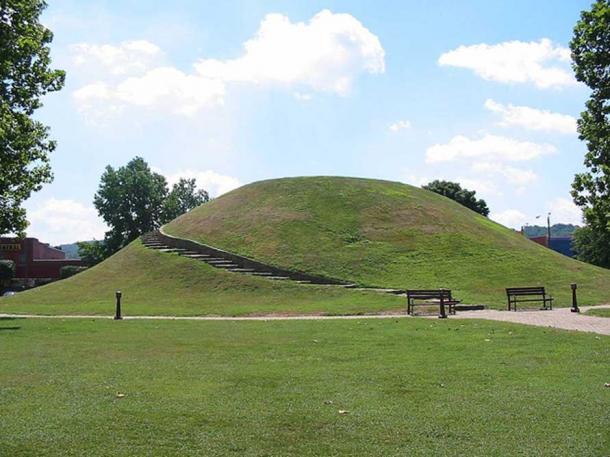
Criel Mound (Public Domain)
Destruction of Evidence
While doing research for a book on this subject over the last several years, the authors were struck by how little of the archaeology of some regions is freely accessible and available to the public. One of those areas is the state of Pennsylvania, where the Carnegie Museum destroyed countless burial mounds without filing comprehensive reports in the late 1800s and early 1900s. Many of the mounds wrecked by the Carnegie are only known to the public from old press reports, such as the following published in The Sun on December 8, 1893:
“This mound, which was originally about 100 feet long and more than 12 feet high, has been somewhat worn down by time. It is on the J.R. Secrist farm in South Huntington township…The most interesting feature in the recent excavation was the mummified torso of the human body…Portions of the bones dug up and the bones in the legs, Prof. Peterson declares, are those of a person between eight and nine feet in height.”
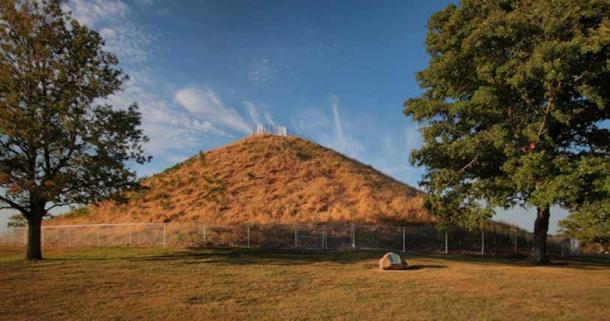
Miamisburg Mound (CC BY-SA 3.0)
Large Skeletal Remains
In order to add some clarity to the subjects of the mound builders and large skeletal remains from Pennsylvania, the authors reviewed a considerable amount of archaeological literature from the state and incorporated the information into several chapters of Ages of the Giants: A Cultural History of the Tall Ones in Prehistoric America (Serpent Mound Books and Press, 2017). Perhaps the most famous instance of press reports describing a large skeleton from a Pennsylvania mound is a case from Union Township in Washington County, Pennsylvania.
In 1932, archaeologist George Fisher excavated the mound after he was informed that amateurs were engaged in heavy looting at the site. This situation attracted hundreds of spectators, and Fisher’s work became a subject of daily discussion by the local media. One discovery in particular was regularly reported at this time:
“One of the most interesting reports that will go into the archives is that on the body of a giant, seven feet five inches tall. This titan was found on the fifth level of the clay mound where the bodies were sandwiched between 11 layers of sandstone. The majority of the adults measured between five feet 10 inches and six feet three inches in stature…”
--The Daily Republican, 9/15/1932
- The Malagana Treasure: Gold and Greed, A Lost Civilization Plundered
- Adena Axis Mundi & Large Skeletal Remains: Archaeology of the Grave Creek Mound - Part I
- The Giants of Doddridge County: Burials of a Vanished Race – Part I
“One of the skeletons of these mighty men is seven feet, five inches in length, and even the remains of the women and children show them to have been of tremendous stature. Heavy, primitive faces must have topped their mammoth bodies, Fisher says, for all of the skulls are heavy boned, with massive jaws and strong teeth that could have ripped meat into shreds…”
--The Pittsburgh Post-Gazette, 9/14/1932
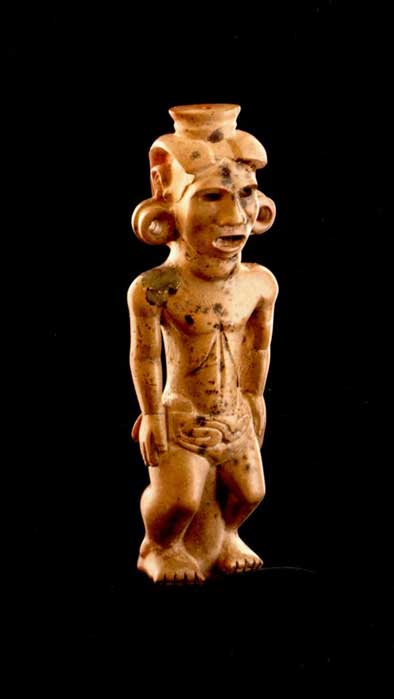
A human effigy pipe created by the prehistoric Adena culture, which lived in the Ohio Valley between 800 BC and 100 AD. (OhioMemory.org)
Mystery of the Mounds
Over the last decade, these types of press reports have caused several researchers to seek out more information on the mound excavated by Fisher, but until now it has remained largely a mystery. The authors found that the site is known in the archaeological literature as the Pollock’s Hill stone mound. There is some debate over the age and cultural affiliations of the mound. Archaeologist and Adena expert Don W. Dragoo considered the Pollock’s Hill Cairn to belong to an Adena stone mound sub-tradition. In more modern times, archaeologists have re-evaluated some of the mounds that Dragoo included in this cultural taxon and have suggested that they could actually date to Late Woodland times—several hundred years after the age of Adena.
One reason for the difficulty in finding professionally documented information on the Pollock’s Hill Cairn is the fact that Fisher himself did not publish the official report. Instead, Donald Cadzow published the report in 1933, utilizing information taken directly from Fisher’s field notes. According to Cadzow’s document, Fisher unearthed an extended adult skeleton covered with packed mud and rocks in the northwestern portion of the mound, which is numbered burial 39 in the field notes. Regarding this burial, Cadzow’s report states, “As the bones were in poor condition, it was impossible to obtain exact measurements. Their size, however, indicated a very large heavy person, much larger than the other burials in the mound.”

Bone size indicated a very large, heavy person. (Public Domain)
Following the excavations, the bones of over 40 skeletons from Pollock’s Hill were transported to the Museum in Harisburg and then to the Smithsonian Institution in Washington. On October 12, 1932, The Pittsburg Press reported that Donald Cadzow himself was the person in charge of transporting the skeletons from Finleyville to the museum, noting, “One skeleton making the trip with Cadzow to the capital is a giant 7 feet 5 inches in height.” The information in the article came from an interview with Cadzow, who took the opportunity to condemn the Carnegie Museum’s handling of Pennsylvania’s prehistory.
Artifacts on record from the Pollock’s Hill Cairn include two rolled copper tubular beads, bone hairpins, stemmed and tanged points, celts, one stone mortar, and perforated bear canine teeth.
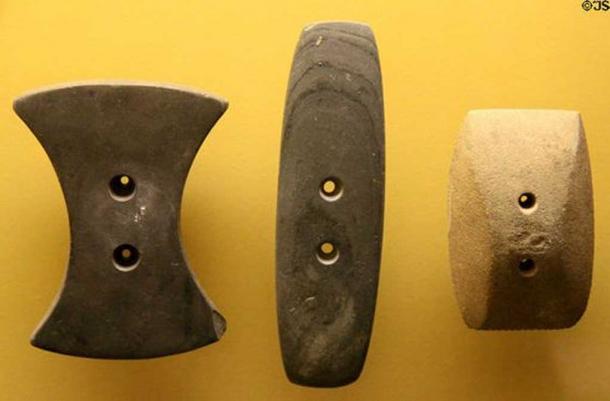
Adena culture gorget ornaments always two holes at Grave Creek Mound Museum. Moundsville, WV. Representative image (Travelphotobase.com)
Field Notes from the Important Site
Large skeletal remains were also recovered from the McKees Rocks Mound, which once overlooked the confluence of the Ohio River and Cartier’s Creek at Stowe Township in Allegheny County, Pennsylvania. Frank Gerodette excavated the McKees Rocks Mound on behalf of the Carnegie Museum in 1896. Unfortunately, several controversies lead to Gerodette’s resignation from the Carnegie and permanent retreat from archaeology before a complete report was filed for the excavations. In Ages of the Giants, we utilized Gerodette’s field notes, as well as the research of five different archaeologists who reviewed the field notes, artifacts, and bones from the mound to recreate the discoveries at this important site. Relevant sources for the information provided here—as well as much more info on the site—can be found in the book.
The McKees Rocks Mound was 16 or 17 feet (4.8 – 5.1 meters) in height at the time of excavation and 85 feet (26 meters) in diameter. There were over 30 burials in the mound of extended, cremated, and bone-bundled human remains, many of which were found in stone cist tombs. The mound was built up in three construction phases, each of which took an unknown length of time to complete. These phases span the time of Adena to the end of the Middle Woodland Period. The oldest or primary phase of the mound was a 3.5-feet-high (one-meter-high) tumulus made of river sand and clay, which covered the skeleton of an Adena female 6-foot-2-inches (188 cm) in length.
Artifacts with this burial include an adze, four deer or elk scapula awls, a copper sheath for an imitation bear canine, 357 columnella shell beads, 153 marginella shell beads, antler and bone flaking tools, and one slate reel-shaped gorget.
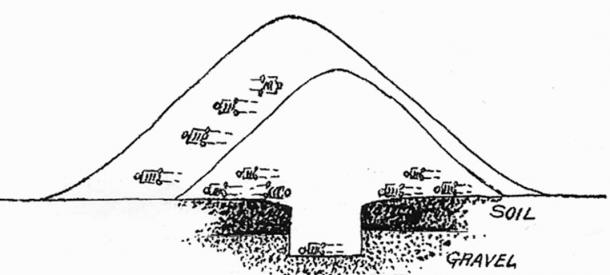
Example sketch of an enlarged Adena mound (Public Domain)
Burial 20 was a female in a sandstone cist tomb. Referring to this burial, Frank Gerodette’s field notes mention, “the person could not have been less than 6-foot-six-inches high” (198 cm). The skull of this burial had been crushed down into the breastbones, and the bones of the feet were missing. According to the historian George Thornton Fleming (who carefully documented the excavations), the remains would have “measured seven feet in height” with the feet and neck intact. There were several other skeletons from McKees Rocks, which measured between 6-feet-2-inches and 6-feet-f4- inches in length.
Squawkie Hill, Curious Burial Mound
In northwestern Pennsylvania, many burial mounds have been attributed to a Hopewell-influenced tradition, which some archaeologists have referred to as the Squawkie Hill Culture . Squawkie Hill mounds are also found in northeastern Ohio, the Upper Ohio Valley in West Virginia, and New York State. These mounds date to the Middle Woodland period, usually between 100 and 500 AD. Squawkie Hill sites in Pennsylvania include the Sugar Run, Corydon, Irvin, and Cornplanter mound groups.
At the Cornplanter Run site in Warren County, Edmund Carpenter investigated two surviving mounds in 1941. He found the mounds to contain circular stone vaults composed of stone slabs, also featuring stone roofing. The tombs were all empty, but one still contained a blade, red ocher, and calcined bone. According to Carpenter’s report, a local artifact collector named Dudley A. Martin had looted the tombs prior to his investigations. Fortunately, Martin himself had gone public with his findings in the January 27, 1937 issue of The Altoona Tribune:
“Dudley A. Martin, octogenarian and collector of Indian relics, states that he was present at the opening of some curious burial mounds on the Cornplanter Indian reservation in Warren County nearly fifty years ago. These barrows were walled up inside and had outlets to the air, so much so that on opening one mound it was found to be full of rattlesnakes…In one mound was found the skeleton of a chief seven feet tall, wearing much barbaric adornment and jewelry.”
- A Glimpse into the Intuitive Medicine of the Native American Tradition
- A Portrait of an Adena Female and Women in Adena Society
- The Mythical Dilmun and The Island of the Dead
There are many similar accounts from burial mounds featuring traits similar to the Cornplanter Mounds along the Pennsylvania—New York State border region:
“…just over the line in Genesee Township, a mound about fourteen feet in diameter, walled up by a stone cairn, about three or four feet high…Some curious persons dug into the side of this mound and brought to light the skeleton of a man of gigantic size, also the bones of a dog, nearly all of the bones crumbing upon exposure to the air…With the bones were found numerous flint arrow-heads, and some stone ornaments, and about a pint of small shells, which also soon disintegrated upon exposure.”
“In December, 1886, W. H. Scoville, of Andrews Settlement, discovered a mound at Ellisburg. On exploring it were found parts of the skeleton of a man measuring between seven and eight feet.”
--Michael A Leeson, History of the Counties of McKean, Elk, Cameron and Potter, Pennsylvania, J.H. Beers & Co., 1860.
“This mound was opened by vandals about 25 years ago, and entire skeletons in a good state of preservation were tossed aside or carried off by schoolboys. Many of the remains were found near the surface, covered by broad flagstones, while others were found at a considerable depth. Great quantities of arrow heads, discoidals, stone axes and beads of various kinds were discovered with the bones. Some of the skeletons were of such large proportions as to indicate that the people who lived in the days when the mound was built were a race of giants.”
--Pittsburgh Daily Post, October 7, 1895.
Archaeological research conducted in recent years indicates that the cultural history of Western Pennsylvania—including the Adena, Hopewell, and Late Woodland mounds—is in need of revision. Perhaps as these new investigations progress, more information on obscure and little-known sites will become available.
Jason Jarrell and Sarah Farmer are investigative historians and avocational archaeologists, and are the authors of Ages of the Giants: A Cultural History of the Tall Ones in Prehistoric America (Serpent Mound Books and Press, 2017). | ParadigmCollision.com
--
Top Image: Hopewell mounds from the Mound City Group in Ohio. Representative image (Heironymous Rowe/CC BY-SA 3.0) Bones, and archaeological sketches of Adena sites. (Public Domain);Deriv.
By Jason Jarrell and Sarah Farmer
Updated on August 5, 2021.
References
Don W. Dragoo, “The Linn Mound: An Upper Ohio Valley Adena Stone Mound”, Pennsylvania Archaeologist 25 (1), 1955.
Mark A. McConaughy, “Reassessing Peter’s Creek and Linn Mounds, Washington County, Pennsylvania”, Pennsylvania Archaeologist 84 (2), 2014.
Donald Cadzow, “Mr. George Fisher’s Discoveries in Western Pennsylvania”, Pennsylvania Archaeologist 3 (3), 1933.
See Chapter 10: “Adena in Pennsylvania”, in Ages of the Giants: A Cultural History of the Tall Ones in Prehistoric America by Jason Jarrell and Sarah Farmer, Serpent Mound Books and Press, 2017.
George Thornton Flemming , History of Pittsburgh and Environs: From Prehistoric Days to the American Revolution, 1922.
See Chapter 15: “The Tall Ones and the Middle Woodland Mounds of the Northeast: The Squawkie Hill Culture”, in Ages of the Giants: A Cultural History of the Tall Ones in Prehistoric America by Jason Jarrell and Sarah Farmer, Serpent Mound Books and Press, 2017.
Edmund Carpenter, “The Irvin, Cornplanter, and Corydon Mounds, Warren County, Pennsylvania”, in Pennsylvania Archaeologist 26 (2), 1956.

















Comments
Greetings everyone. I just wanted to stop in and address several comments made in this thread—all for your learning pleasure, of course. Since writing this article and the book “Ages of the Giants”, I was able to secure the data from DNA tests performed on skeletons from 5 Adena and 3 Hopewell mounds. Using the information we actually traced several members of the burial population to existing Native American tribes. As it turns out, individuals with the unique physiology of the Tall Ones still exist among these tribes and indeed, are on record since Westerners first reached the Americas. We chose to not publish on the identities of these individuals because at the end of the day, these are human beings, and we didnt want the “Nephilim” and “Alien Hybrid” groups exploiting them. Unsurprisingly, many of these people are athletes and several are even artists. The important takeaway here is that these people never “died out.” They never disappeared and in fact, many of the old press reports of “ancient giants” are of burials made during the historic period. As an example, roughly 70 percent of the “giant skeleton” press reports from the northeast are from historic Iroquois burial sites. You can consult my article on The Adena-Hopewell Moon that was published longform with Ancient Origins several years ago to find a study of how the culture of one particular tribe can be demonstrated to correspond with the mythology represented at several major Adena-Hopewell earthworks. Cheers!
Jason Jarrell
It's not a big secret that a lot of evidence that was found about the mound builders has been destroyed or 'lost' if they admit that they were tall, well built humans here then it would be admitting that the America's were discovered way before 1492 & they can't do that.
Jody D Hoffman
If these giants existed, archaeologists should find out how and why they died out. I’ve heard of people saying they were created by demons and that’s why they were wiped out. If that’s the case, why doesn’t God wipe out Devil Worshippers such as Marilyn Manson and other Devil Worshippers.
With one small assumption? Yes Pete. Science is based on assumptions. Deceivers and Mavericks? Now there's the nub of it. Anyone that disagrees with you is a deceiver, and you and your mavericks are framed as heroic in your mind. Well I definitely disagree with you on most things you've ever posted. Especially this race of subterranean people that lived across the world. Show me the unequivocal evidence for your very speculative idea, rather than the results of your fevered imagination. Then maybe we could actually have a mutually enlightening conversation.
Crasslee
edit
Pages